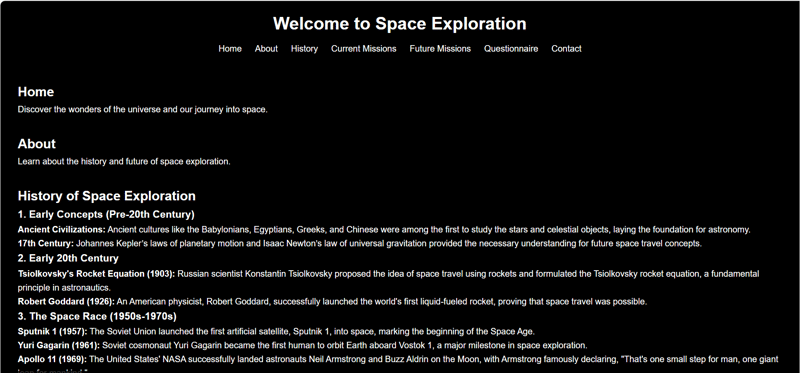前端尝试
这是前端挑战 v24.09.04 的提交内容,美化我的标记:Space
我建造了什么
我构建了一个以太空为主题的登陆页面,提供有关太空探索的信息。目标是创造一个有吸引力的简约设计,突出太空历史、当前任务、未来任务等的关键方面。该页面包括主页、关于、历史、当前任务、未来任务、调查问卷和联系信息等部分。
演示
您可以在此处实时查看该项目。以下是登陆页面的屏幕截图:

太空探索登陆页面
您也可以在Github上查看代码
旅程
创建这个项目是一次令人兴奋的旅程。以下是有关该过程的一些要点:
设计和布局:我的目标是干净简约的设计,带有黑暗的太空主题背景,以创造身临其境的体验。布局简单但信息丰富,使用户可以轻松浏览不同的部分。
内容:我包含了有关太空探索历史、当前和未来任务的详细信息。问卷部分允许用户互动并分享他们对太空探索的想法。
挑战:挑战之一是确保动画交互在不同设备和屏幕尺寸上顺利运行。在这个过程中我学到了很多关于响应式设计和跨浏览器兼容性的知识。
未来计划:我计划添加更多互动元素,例如有关太空事实的测验和太空探索中重大事件的时间表。我也希望整合更高级的动画和转场,让页面更加吸引人。
代码
HTML
<!DOCTYPE html>
<html lang="en">
<head>
<meta charset="UTF-8">
<meta name="viewport" content="width=device-width, initial-scale=1.0">
<title>Space Exploration</title>
<link rel="stylesheet" href="styles.css">
</head>
<body>
<header class="space-background">
<h1>Welcome to Space Exploration</h1>
<nav>
<ul>
<li><a href="#home">Home</a></li>
<li><a href="#about">About</a></li>
<li><a href="#history">History</a></li>
<li><a href="#current-missions">Current Missions</a></li>
<li><a href="#future-missions">Future Missions</a></li>
<li><a href="#questionnaire">Questionnaire</a></li>
<li><a href="#contact">Contact</a></li>
</ul>
</nav>
</header>
<main class="space-background">
<section id="home">
<h2>Home</h2>
<p>Discover the wonders of the universe and our journey into space.</p>
</section>
<section id="about">
<h2>About</h2>
<p>Learn about the history and future of space exploration.</p>
</section>
<section id="history">
<h2>History of Space Exploration</h2>
<h3>1. Early Concepts (Pre-20th Century)</h3>
<p><strong>Ancient Civilizations:</strong> Ancient cultures like the Babylonians, Egyptians, Greeks, and Chinese were among the first to study the stars and celestial objects, laying the foundation for astronomy.</p>
<p><strong>17th Century:</strong> Johannes Kepler’s laws of planetary motion and Isaac Newton’s law of universal gravitation provided the necessary understanding for future space travel concepts.</p>
<h3>2. Early 20th Century</h3>
<p><strong>Tsiolkovsky's Rocket Equation (1903):</strong> Russian scientist Konstantin Tsiolkovsky proposed the idea of space travel using rockets and formulated the Tsiolkovsky rocket equation, a fundamental principle in astronautics.</p>
<p><strong>Robert Goddard (1926):</strong> An American physicist, Robert Goddard, successfully launched the world's first liquid-fueled rocket, proving that space travel was possible.</p>
<h3>3. The Space Race (1950s-1970s)</h3>
<p><strong>Sputnik 1 (1957):</strong> The Soviet Union launched the first artificial satellite, Sputnik 1, into space, marking the beginning of the Space Age.</p>
<p><strong>Yuri Gagarin (1961):</strong> Soviet cosmonaut Yuri Gagarin became the first human to orbit Earth aboard Vostok 1, a major milestone in space exploration.</p>
<p><strong>Apollo 11 (1969):</strong> The United States' NASA successfully landed astronauts Neil Armstrong and Buzz Aldrin on the Moon, with Armstrong famously declaring, "That's one small step for man, one giant leap for mankind."</p>
<h3>4. Post-Moon Landings and the Space Shuttle Era (1970s-1990s)</h3>
<p><strong>Space Stations:</strong></p>
<ul>
<li><strong>Salyut and Mir (1971-1986):</strong> The Soviet Union launched a series of space stations, culminating in the long-lasting Mir, which operated until 2001.</li>
<li><strong>Skylab (1973):</strong> The United States launched its first space station, Skylab, which was operational for six years.</li>
</ul>
<p><strong>Space Shuttle Program (1981-2011):</strong> NASA’s reusable Space Shuttle fleet completed 135 missions over 30 years, including launching satellites, conducting scientific research, and assembling the International Space Station (ISS).</p>
<h3>5. International Cooperation and Space Exploration (1990s-Present)</h3>
<p><strong>International Space Station (ISS) (1998-present):</strong> A joint effort by NASA, Roscosmos (Russia), ESA (Europe), JAXA (Japan), and other partners, the ISS serves as a hub for scientific research and international collaboration in low Earth orbit.</p>
<p><strong>Mars Exploration:</strong></p>
<ul>
<li><strong>Rovers and Orbiters:</strong> The Mars rovers like Spirit, Opportunity, Curiosity, and Perseverance have provided detailed information about the Martian surface and its potential to support life.</li>
<li><strong>ExoMars (2020):</strong> A European-Russian mission designed to search for signs of life on Mars.</li>
</ul>
<h3>6. Private Space Exploration and the Future (2000s-Present)</h3>
<p><strong>Commercial Spaceflight:</strong> Companies like SpaceX, Blue Origin, and Virgin Galactic are pioneering commercial space travel, aiming to make space more accessible to private individuals and researchers.</p>
</section>
<section id="current-missions">
<h2>Current Missions</h2>
<p>Explore the ongoing missions that are expanding our understanding of the universe.</p>
</section>
<section id="future-missions">
<h2>Future Missions</h2>
<p>Learn about the upcoming missions that aim to push the boundaries of space exploration.</p>
</section>
<section id="questionnaire">
<h2>Questionnaire</h2>
<form>
<label for="name">Name:</label>
<input type="text" id="name" name="name" required><br><br>
<label for="email">Email:</label>
<input type="email" id="email" name="email" required><br><br>
<label for="question1">1. What is your favorite planet?</label><br>
<input type="text" id="question1" name="question1" required><br><br>
<label for="question2">2. Have you ever visited a space museum?</label><br>
<input type="radio" id="yes" name="question2" value="yes">
<label for="yes">Yes</label><br>
<input type="radio" id="no" name="question2" value="no">
<label for="no">No</label><br><br>
<label for="question3">3. What interests you the most about space exploration?</label><br>
<textarea id="question3" name="question3" rows="4" cols="50" required></textarea><br><br>
<input type="submit" value="Submit">
</form>
</section>
<section id="contact">
<h2>Contact</h2>
<p>Get in touch with us for more information about space exploration.</p>
</section>
</main>
<footer class="space-background">
<p>© 2024 Space Exploration. All rights reserved.</p>
</footer>
</body>
</html>
CSS
* {
margin: 0;
padding: 0;
box-sizing: border-box;
}
body {
font-family: Arial, sans-serif;
line-height: 1.6;
background-color: #000;
color: #fff;
}
.space-background {
background: rgba(0, 0, 0, 0.8) url('https://www.nasa.gov/sites/default/files/thumbnails/image/potw2048a.jpg') no-repeat center center;
background-size: cover;
}
header {
padding: 1rem 0;
text-align: center;
}
header h1 {
margin-bottom: 0.5rem;
}
nav ul {
list-style: none;
padding: 0;
}
nav ul li {
display: inline;
margin: 0 10px;
}
nav ul li a {
color: #fff;
text-decoration: none;
}
main {
padding: 2rem;
}
section {
margin-bottom: 2rem;
}
form {
background: rgba(255, 255, 255, 0.1);
padding: 1rem;
border-radius: 5px;
}
form label {
display: block;
margin-bottom: 0.5rem;
}
form input[type="text"],
form input[type="email"],
form textarea {
width: 100%;
padding: 0.5rem;
margin-bottom: 1rem;
border: none;
border-radius: 5px;
}
form input[type="submit"] {
background: #333;
color: #fff;
border: none;
padding: 0.5rem 1rem;
border-radius: 5px;
cursor: pointer;
}
form input[type="submit"]:hover {
background: #555;
}
footer {
text-align: center;
padding: 1rem 0;
position: fixed;
width: 100%;
bottom: 0;
}
团队
这个项目是一个人的努力,但我想归功于以下资源和灵感:
NASA 令人惊叹的太空图像。
MDN Web 文档,提供有关 Web 开发的优秀文档。
许可证
该项目根据 MIT 许可证获得许可。请随意使用和修改您认为合适的代码。
以上是前端尝试的详细内容。更多信息请关注PHP中文网其他相关文章!

热AI工具

Undresser.AI Undress
人工智能驱动的应用程序,用于创建逼真的裸体照片

AI Clothes Remover
用于从照片中去除衣服的在线人工智能工具。

Undress AI Tool
免费脱衣服图片

Clothoff.io
AI脱衣机

Video Face Swap
使用我们完全免费的人工智能换脸工具轻松在任何视频中换脸!

热门文章

热工具

记事本++7.3.1
好用且免费的代码编辑器

SublimeText3汉化版
中文版,非常好用

禅工作室 13.0.1
功能强大的PHP集成开发环境

Dreamweaver CS6
视觉化网页开发工具

SublimeText3 Mac版
神级代码编辑软件(SublimeText3)
 Python vs. JavaScript:学习曲线和易用性
Apr 16, 2025 am 12:12 AM
Python vs. JavaScript:学习曲线和易用性
Apr 16, 2025 am 12:12 AM
Python更适合初学者,学习曲线平缓,语法简洁;JavaScript适合前端开发,学习曲线较陡,语法灵活。1.Python语法直观,适用于数据科学和后端开发。2.JavaScript灵活,广泛用于前端和服务器端编程。
 JavaScript和Web:核心功能和用例
Apr 18, 2025 am 12:19 AM
JavaScript和Web:核心功能和用例
Apr 18, 2025 am 12:19 AM
JavaScript在Web开发中的主要用途包括客户端交互、表单验证和异步通信。1)通过DOM操作实现动态内容更新和用户交互;2)在用户提交数据前进行客户端验证,提高用户体验;3)通过AJAX技术实现与服务器的无刷新通信。
 JavaScript在行动中:现实世界中的示例和项目
Apr 19, 2025 am 12:13 AM
JavaScript在行动中:现实世界中的示例和项目
Apr 19, 2025 am 12:13 AM
JavaScript在现实世界中的应用包括前端和后端开发。1)通过构建TODO列表应用展示前端应用,涉及DOM操作和事件处理。2)通过Node.js和Express构建RESTfulAPI展示后端应用。
 了解JavaScript引擎:实施详细信息
Apr 17, 2025 am 12:05 AM
了解JavaScript引擎:实施详细信息
Apr 17, 2025 am 12:05 AM
理解JavaScript引擎内部工作原理对开发者重要,因为它能帮助编写更高效的代码并理解性能瓶颈和优化策略。1)引擎的工作流程包括解析、编译和执行三个阶段;2)执行过程中,引擎会进行动态优化,如内联缓存和隐藏类;3)最佳实践包括避免全局变量、优化循环、使用const和let,以及避免过度使用闭包。
 Python vs. JavaScript:社区,图书馆和资源
Apr 15, 2025 am 12:16 AM
Python vs. JavaScript:社区,图书馆和资源
Apr 15, 2025 am 12:16 AM
Python和JavaScript在社区、库和资源方面的对比各有优劣。1)Python社区友好,适合初学者,但前端开发资源不如JavaScript丰富。2)Python在数据科学和机器学习库方面强大,JavaScript则在前端开发库和框架上更胜一筹。3)两者的学习资源都丰富,但Python适合从官方文档开始,JavaScript则以MDNWebDocs为佳。选择应基于项目需求和个人兴趣。
 Python vs. JavaScript:开发环境和工具
Apr 26, 2025 am 12:09 AM
Python vs. JavaScript:开发环境和工具
Apr 26, 2025 am 12:09 AM
Python和JavaScript在开发环境上的选择都很重要。1)Python的开发环境包括PyCharm、JupyterNotebook和Anaconda,适合数据科学和快速原型开发。2)JavaScript的开发环境包括Node.js、VSCode和Webpack,适用于前端和后端开发。根据项目需求选择合适的工具可以提高开发效率和项目成功率。
 C/C在JavaScript口译员和编译器中的作用
Apr 20, 2025 am 12:01 AM
C/C在JavaScript口译员和编译器中的作用
Apr 20, 2025 am 12:01 AM
C和C 在JavaScript引擎中扮演了至关重要的角色,主要用于实现解释器和JIT编译器。 1)C 用于解析JavaScript源码并生成抽象语法树。 2)C 负责生成和执行字节码。 3)C 实现JIT编译器,在运行时优化和编译热点代码,显着提高JavaScript的执行效率。
 Python vs. JavaScript:比较用例和应用程序
Apr 21, 2025 am 12:01 AM
Python vs. JavaScript:比较用例和应用程序
Apr 21, 2025 am 12:01 AM
Python更适合数据科学和自动化,JavaScript更适合前端和全栈开发。1.Python在数据科学和机器学习中表现出色,使用NumPy、Pandas等库进行数据处理和建模。2.Python在自动化和脚本编写方面简洁高效。3.JavaScript在前端开发中不可或缺,用于构建动态网页和单页面应用。4.JavaScript通过Node.js在后端开发中发挥作用,支持全栈开发。






